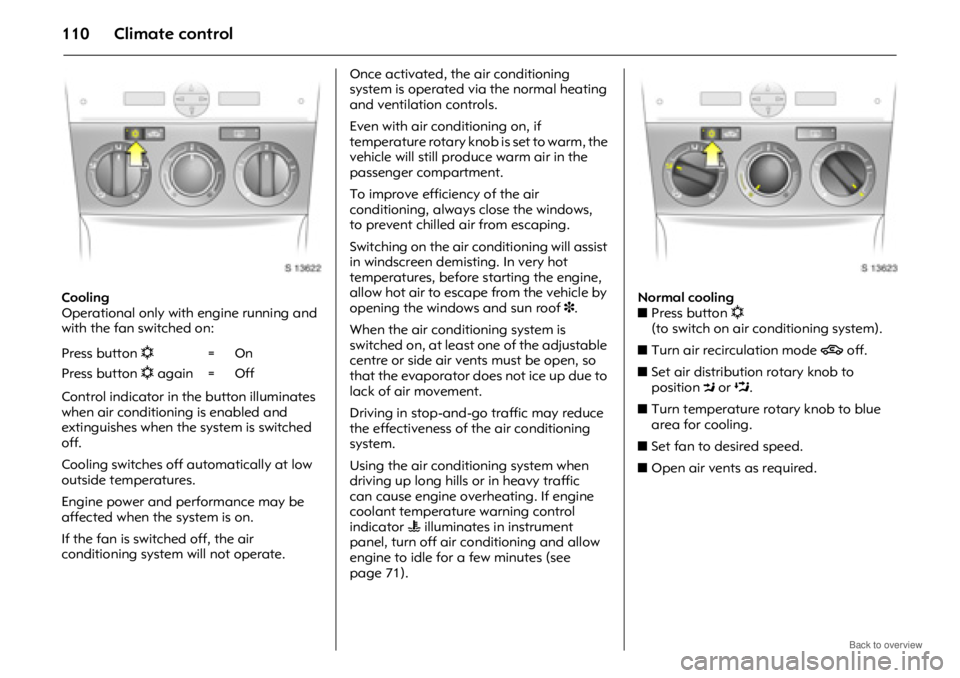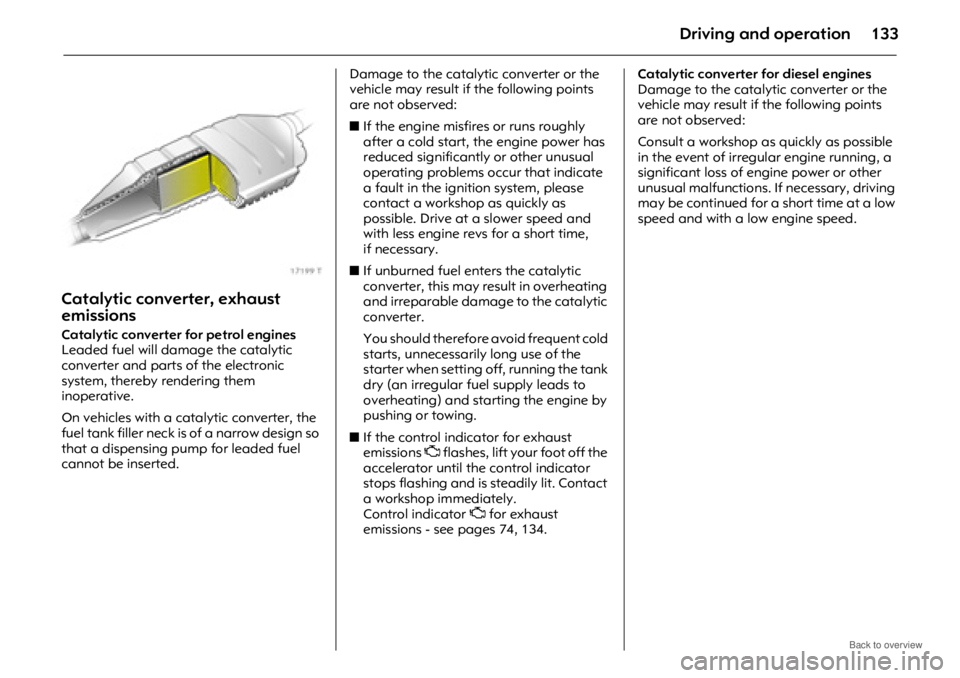overheating OPEL ANTARA 2009 Owners Manual
[x] Cancel search | Manufacturer: OPEL, Model Year: 2009, Model line: ANTARA, Model: OPEL ANTARA 2009Pages: 234, PDF Size: 3.01 MB
Page 110 of 234

Climate control110
Cooling
Operational only with engine running and
with the fan switched on:
Control indicator in the button illuminates
when air conditioning is enabled and
extinguishes when the system is switched
off.
Cooling switches off automatically at low
outside temperatures.
Engine power and performance may be
affected when the system is on.
If the fan is switched off, the air
conditioning system will not operate. Once activated, the air conditioning
system is operated via the normal heating
and ventilation controls.
Even with air conditioning on, if
temperature rotary knob is set to warm, the
vehicle will still produce warm air in the
passenger compartment.
To improve efficiency of the air
conditioning, always close the windows,
to prevent chilled air from escaping.
Switching on the air conditioning will assist
in windscreen demisting. In very hot
temperatures, before starting the engine,
allow hot air to escape from the vehicle by
opening the windows and sun roof
3.
When the air conditioning system is
switched on, at least one of the adjustable
centre or side air vents must be open, so
that the evaporator does not ice up due to
lack of air movement.
Driving in stop-and-go traffic may reduce
the effectiveness of the air conditioning
system.
Using the air conditioning system when
driving up long hills or in heavy traffic
can cause engine overheating. If engine
coolant temperature warning control
indicator W illuminates in instrument
panel, turn off air co nditioning and allow
engine to idle for a few minutes (see
page 71). Normal cooling
z
Press button n
(to switch on air co nditioning system).
z Turn air recirculation mode 4 off.
z Set air distribution rotary knob to
position M or L.
z Turn temperature rotary knob to blue
area for cooling.
z Set fan to desired speed.
z Open air vents as required.
Press button
n=On
Press button n again = Off
Page 125 of 234

Driving and operation125
Self-help
Recovery and towing
When recovering or towing a vehicle
off-road, observe the following:
zA greater force is required to move a
vehicle from or through mud than when
on a hard surfaced road.
z Attach a tow rope to the towing eye of
the vehicle, not to the axle -
see pages 164, 174.
z Where possible, drive both vehicles
forward to affect a recovery, using an
appropriate gear to avoid wheelspin.
z Avoid the use of reverse gear because of
possible resultant wheelspin.
z Stay clear of the tow rope.
Wheel changing
Place a board or plate beneath the jack, to
prevent it from sinking into soft ground.
Further information - see page 178. Cleaning
Clean the vehicle thoroughly and as soon
as possible after driving off-road.
Do not let mud remain dry on any part of
the vehicle as it becomes abrasive and can
damage paint, glass, seals, bearings and
brake components.
If left to build up, mud can seriously affect
the air flow through and over mechanical
components and cause localised
overheating and failure of parts, especially
in the engine compartment.
Ensure the radiator core and the area
between the radiator and intercooler/oil
cooler (where installed) is cleaned, to
maintain proper cooling air flow.
Check the radiator and cooler cores for
blockage (sand, silt etc.).
Check the tyre treads.
Clean and check the mechanical parts of
the vehicle, particularly the following
areas:
z
Driveshafts, including sealing bellows,
z Front brake calipers, pads and discs,
z Front suspension,
z Clutch fork sealing bellows,
z Rear brake calipers, pads and discs,
z Rear suspension,
z Fuel tank and underguard,
z Breathers, axles and fuel tank,
z Load sensing valve,
z Transfer box and underguard,
z Engine oil pan and underguard.
Observe the following:
z Do not spray high-pressure water
directly at the vehicle seals.
z The wheels must be removed to clean all
mud and stones from the brake calipers
and to check brake pad wear.
z The areas on the upper side of the
underguards must be cleared of stones,
to prevent damage to the engine oil pan
and the fuel tank.
9 Warning
Breaking ropes can cause serious injury.
Page 128 of 234

Driving and operation128
Switching off the engine
If the engine temperature is very high, e.g.
after driving in mountainous terrain: allow
engine to idle for approx. 2 minutes, in
order to prevent heat accumulation.
When you switch off, fans in the engine
compartment may continue running for a
time, to cool the engine.
Vehicles with turbocharger 3
In order to protect the turbocharger, after
running at high engine speeds or high
engine loads, operate the engine briefly at
a low load or run in neutral for approx.
30 seconds before switching off.
Save energy – more kilometres/miles
Please observe the running-in hints on the
previous page and the tips for energy
saving on the following pages.
Good, technically correct and economical
driving ensures maximum durability and
performance for your vehicle.
Overrun
The fuel supply is automatically shut off
during overrun, e.g. when the vehicle is
being driven down long gradients or during
braking. To enable the overrun cut-off to
come into action, do not accelerate or
declutch during overrun. Engine rpm
Under all driving conditions, drive in a
favourable engine speed range.
Warming up
Allow engine to warm up while driving. Do
not warm it up by le
tting it run at idling
speed. Do not apply full throttle until
engine reaches operating temperature.
After a cold start, automatic
transmission 3 does not shift into higher
gears until higher engine speeds have been
reached. This allows the catalytic converter
to quickly reach the temperature required
for optimum pollutant reduction.
Correct gear selection
Do not race your engine whilst in neutral or
with a low gear selected. Driving too fast in
individual gears or drive ranges as well as
stop-and-go traffic in crease engine wear
and fuel consumption.
Change down
When decreasing speed, shift down into
the next lowest gear. Do not slip the clutch
with a high-revving engine. This is
especially important when hill climbing. Clutch operation
3
Always depress the clutch pedal hard to
the floor, to prevent shifting difficulties and
transmission damage. There must be no
mats in the area of the pedals.
When driving, do not use the clutch pedal
as a foot rest; this will cause substantial
clutch wear.
Pedals
Do not place any objects in the footwell
which could slip under the pedals and
inhibit the pedal travel.
To ensure the pedal travel is uninhibited,
there must be no mats in the area of the
pedals.
When driving, do not use the brake pedal
as a foot rest; this will cause substantial
wear to brake components and cause
overheating, resultin g in longer braking
distances.
Battery care whilst driving
When driving slowly or when the vehicle
is stationary, e.g. in slow urban traffic,
stop-and-go traffic or traffic jams, turn off
all unnecessary electrical loads where
possible (e.g. heated rear window,
auxiliary headlamps).
When starting the engine, depress the
clutch pedal so that transmission
resistance is elimin ated and the starter
motor and battery are relieved.
Page 133 of 234

Driving and operation133
Catalytic converter, exhaust
emissions
Catalytic converter for petrol engines
Leaded fuel will damage the catalytic
converter and parts of the electronic
system, thereby rendering them
inoperative.
On vehicles with a catalytic converter, the
fuel tank filler neck is of a narrow design so
that a dispensing pump for leaded fuel
cannot be inserted. Damage to the catalytic converter or the
vehicle may result if the following points
are not observed:
z
If the engine misfires or runs roughly
after a cold start, the engine power has
reduced significantly or other unusual
operating problems occur that indicate
a fault in the ignition system, please
contact a workshop as quickly as
possible. Drive at a slower speed and
with less engine revs for a short time,
if necessary.
z If unburned fuel enters the catalytic
converter, this may re sult in overheating
and irreparable damage to the catalytic
converter.
You should therefore avoid frequent cold
starts, unnecessarily long use of the
starter when setting off, running the tank
dry (an irregular fuel supply leads to
overheating) and starting the engine by
pushing or towing.
z If the control indicator for exhaust
emissions Z flashes, lift your foot off the
accelerator until th e control indicator
stops flashing and is steadily lit. Contact
a workshop immediately.
Control indicator Z for exhaust
emissions - see pages 74, 134. Catalytic converter for diesel engines
Damage to the catalytic converter or the
vehicle may result if the following points
are not observed:
Consult a workshop as quickly as possible
in the event of irregular engine running, a
significant loss of engine power or other
unusual malfunctions. If necessary, driving
may be continued for a
short time at a low
speed and with a low engine speed.
Page 169 of 234

Driving and operation169
Driving characteristics, towing tips
In the case of caravans/trailers with
brakes3, attach the breakaway stopping
cable to the eye 3 or loop around coupling
ball bar if no eye is available.
Ensure cable is crossed under the coupling
socket to ensure the caravan/trailer nose
cannot drop to the ground if it becomes
separated from the trailer hitch.
Do not allow the cable to drag along the
ground and always allow enough slack to
permit full turning. Fo llow the instructions
supplied with the towing equipment.
Before coupling the caravan/trailer,
lubricate the ball of the caravan/trailer
towing device. However, do not do so if a
stabilizer which acts on the coupling ball is
being used to damp rolling motions.
Handling is greatly influenced by the
loading of the caravan/trailer. Loads
should therefore be secured so that they
cannot slip and should be placed in the
centre of the caravan/trailer if possible,
i.e. above the axle.
Opel genuine parts an d accessories which
can be subsequently fitted aid trailer
operation, e.g. larg e mirrors for wide
caravans/trailers. In the case of caravans/trailers with low
directional stability, it is advisable to use a
friction-type stabilizer to damp rolling
motions.
Do not drive faster than 80 km/h (50 mph),
even in countries where higher speeds are
permitted.
When driving uphill, do not drive faster
than 30 km/h (20 mph) in 1st gear, or
50 km/h (30 mph) in 2nd gear.
Make sure that you have enough room
when cornering and avoid sudden
manoeuvres.
If the caravan/trailer starts to sway, drive
more slowly, do not attempt to correct the
steering and brake sharply if necessary.
If it is necessary to apply the brakes fully,
depress the brake pedal as hard as
possible.
The cooling fan is electrically operated.
The fan cooling capacity is not, therefore,
dependent on engine speed. It is not
necessary, when drivin
g uphill, to shift
down into a lower gear if the vehicle can
climb in a higher gear. When coupled to a caravan/trailer, the
vehicle requires more
braking effort when
driving down long grad ients, so select the
same gear as you would when driving
uphill and drive at roughly the same speed.
Automatic transmission in automatic mode
will select the drivin g program with the
optimum engine braking effect.
Remember that brak ing distances for
vehicles towing carava ns/trailers with and
without brakes is always greater than for
vehicles not towing a caravan/trailer. For
caravans/trailers with brakes, follow the
instructions carefully. Do not make any
modifications to the brake system.
Always check lamps on caravans/trailers
before towing. Ensure national regulations
are observed.
The fog tail lamp on the vehicle is
deactivated when towing a caravan/
trailer.
When reversing, if possible, have someone
provide assistance.
Drive slowly and shift down into a lower
gear when descending steep gradients
rather than holding the foot brake
depressed, to avoid overheating and
reduced brake efficiency.